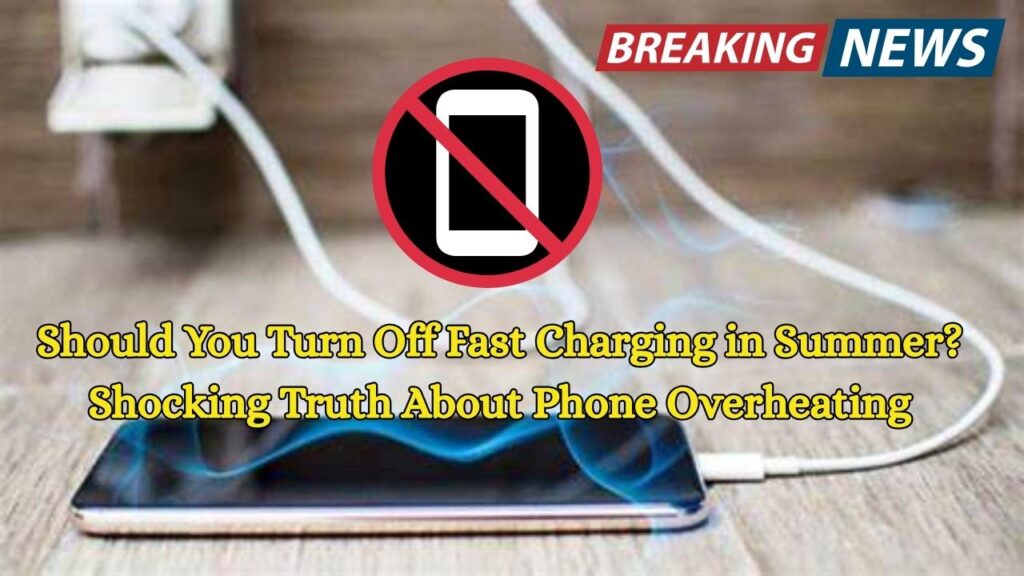Should You Turn Off Fast Charging in Summer -When summer temperatures soar, your smartphone could be in danger—and fast charging might be making it worse. Many users have reported their phones heating up dramatically during hot days, especially while using quick-charging features. But is turning off fast charging in summer the right move to protect your device? Let’s explore the science, the risks, and the expert advice to help you keep your phone safe, cool, and long-lasting.

Modern smartphones are designed to handle heat, but even the best devices can struggle when fast charging and high ambient temperatures collide. With battery health, performance, and even safety at stake, it’s essential to understand how charging habits affect your phone—particularly in hot weather.
Should You Turn Off Fast Charging in Summer
| Topic | Details |
|---|---|
| Main Concern | Overheating of smartphones during fast charging in summer |
| Risk | Battery damage, slower charging speeds, thermal shutdown |
| Best Practice | Turn off fast charging when temperatures exceed 35°C |
| Supporting Data | Phone batteries operate best between 20°C – 30°C (Apple & Samsung guidelines) |
| Safety Measures | Charge in cool areas, avoid direct sunlight, remove phone case |
| Useful Feature | Use “Optimized Charging” or “Adaptive Battery” modes |
| Expert Source | Indian Express |
| Official Resource | Apple Battery Health |
Turning off fast charging in summer can protect your phone from overheating, extend its battery life, and improve safety. While fast charging is convenient, it’s not always worth the thermal risk—especially in countries like India where summer temperatures routinely cross 40°C. Combine slower charging with good charging practices, and you’ll get more out of your smartphone for years to come.
Why Fast Charging Becomes Risky in Summer?
Fast charging works by delivering a higher current to the phone’s battery to fill it up quickly—often going from 0% to 50% in just 30 minutes. But this extra power flow generates more heat, and when your phone is already in a warm environment (like inside a car, near a window, or even your pocket), the risk of overheating increases significantly.
According to Apple, iPhones are designed to perform best between 0°C and 35°C. The battery lifespan can degrade if the device is regularly exposed to temperatures above that range, especially during charging. Samsung also advises against charging phones in hot areas to avoid internal temperature spikes.
Example: Summer Charging Gone Wrong
Imagine placing your phone on fast charge near a sunny window in June. The outside temperature is 38°C. Within minutes, your device starts heating up rapidly. You feel it getting hot to the touch. The battery app shows it’s stuck at 80% with no increase for several minutes. Eventually, the phone slows charging or stops altogether. That’s your smartphone trying to protect itself—but it’s a warning sign.
What Happens When a Phone Overheats While Charging?
When your phone gets too hot during charging, it can trigger several safety mechanisms:
- Battery throttling: Slows or stops the charging process.
- Processor slowdown: Reduces phone performance.
- Warning alerts: Some phones display an overheating message.
- Auto-shutdown: To prevent damage, the phone may turn off entirely.
These are smart protections, but if overheating becomes frequent, long-term battery damage and shorter phone lifespan are likely outcomes.
Should You Turn Off Fast Charging in Summer? Experts Say Yes
Yes, disabling fast charging during summer is a smart move—especially if you often charge in warm environments. Fast charging isn’t essential every time, and turning it off can greatly reduce the thermal load on your device.
How to Turn Off Fast Charging?
Depending on your phone, here’s how you can disable it:
- Samsung: Go to Settings > Battery and device care > Battery > More battery settings → Turn off “Fast charging”.
- OnePlus: Some models allow disabling “Warp Charge” in battery settings or developer options.
- iPhone: iPhones don’t offer manual control, but enabling Optimized Battery Charging helps reduce heat stress.
Benefits of Turning Off Fast Charging in Summer
1. Less Heat Generation
Fast charging inherently produces heat. By switching to standard charging, your phone stays cooler—even in higher ambient temperatures.
2. Longer Battery Life
According to Battery University, lithium-ion batteries last longer when kept below 35°C. Less heat equals slower degradation.
3. Lower Risk of Accidental Damage
Phones left on fast charge in hot environments can swell, shut down, or in rare cases, ignite. While rare, disabling fast charging is a simple safety precaution.
4. Improved Charging Stability
Standard charging maintains a more consistent temperature range, reducing charging disruptions caused by overheating-related throttling.
5. Better Performance While Charging
Phones tend to lag when charging under stress. By avoiding fast charging in summer, you can keep your device cooler and more responsive.
Tips to Keep Your Phone Cool While Charging
Here’s how to further reduce your phone’s risk of overheating:
- Charge in shade or cool rooms.
- Remove the case.
- Avoid intensive use during charging.
- Use certified chargers only.
- Turn on battery health features.
- Monitor battery temperature with apps like AccuBattery (Android) or Battery Life Doctor (iOS).
Real User Experiences and Data
A Reddit thread from Android users (source) highlights that multiple people experience slowdowns and heating problems when fast charging in summer. In particular, users in India and the Middle East frequently report phones crossing 40°C during midday charging.
Similarly, a NY Post report emphasizes that using fast charge repeatedly during hot days is one of the worst things you can do for your phone.
A Time.com guide also lists turning off fast charging as one of the best ways to prevent overheating during extreme temperatures.
New BVI Work Visa Rules for 2025 – Are You Eligible? Find Out Now!
UP GNM Entrance Test UPGET 2025 Application Form – Apply Online, Check Last Date
NTA CUET UG 2025 Date Sheet (Soon), Check Pattern, Exam City Slip
FAQs about Should You Turn Off Fast Charging in Summer
Q1. Will disabling fast charging slow my phone too much?
Yes, but only slightly. Instead of charging from 0–100% in 1 hour, it might take 1.5 to 2 hours. In exchange, your battery stays healthier.
Q2. Can I enable fast charging again in winter?
Absolutely. When the ambient temperature is cooler (below 30°C), fast charging is less likely to cause overheating.
Q3. Does turning off fast charging affect overall phone performance?
No. Charging speed is independent of CPU or app performance.
Q4. Should I turn off my phone while charging in summer?
Turning it off or using airplane mode can reduce power demand and internal heating, especially if you’re charging outdoors.
Q5. Are newer phones better at handling heat?
Yes, flagship devices in 2024–2025 include advanced thermal management, but they are still not immune to heat-induced slowdowns.
Q6. Can I schedule slow charging during nighttime to avoid heat?
Yes. Many phones allow scheduled or optimized charging, especially overnight, which reduces heat buildup and aligns with cooler room temperatures.









